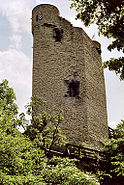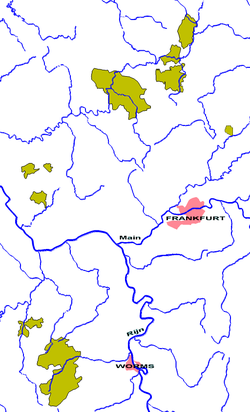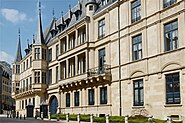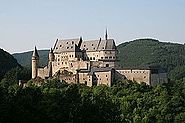- This article is about the European aristocratic dynasty. For the former state ruled by this dynasty, the Countship and later Duchy of Nassau, see Nassau (state). For other uses, see Nassau (disambiguation)

Arms of Nassau: Azure billetty or, a lion rampant of the last armed and langued gules
The House of Nassau is a diversified aristocratic dynasty in Europe. It is named after the lordship associated with Nassau Castle, located in present-day Nassau, Rhineland-Palatinate, Germany. The lords of Nassau were originally titled Count of Nassau, then elevated to the princely class as princely counts. At the end of the Holy Roman Empire, they proclaimed themselves Dukes of Nassau, forming the independent state Nassau in what is now the German states of Rhineland-Palatinate and Hesse. The duchy was annexed by Prussia in 1866, when it was incorporated into the new Province of Hesse-Nassau. Today Nassau is a geographical, historical and cultural region in Germany.
All Dutch monarchs since 1890 and the Grand Dukes of Luxembourg since 1912 have been descended in the female line from the House of Nassau. According to German tradition, the family name is passed only in the male line of succession. The house is therefore, from this perspective, extinct since 1985.[1] However Dutch aristocratic customs (and Luxembourg's, which are based on the aforementioned) differ, and do not consider the House extinct. The Grand Duke of Luxembourg uses "Duke of Nassau" as his secondary title and a title of pretense.
Origins[]
Count Dudo-Henry of Laurenburg (ca. 1060 – ca. 1123) is considered the founder of the House of Nassau. He is first mentioned in the purported founding-charter of Maria Laach Abbey in 1093 (although many historians consider the document to be fabricated). The Castle Laurenburg, located a few miles upriver from Nassau on the Lahn, was the seat of his lordship. His family probably descended from the Lords of Lipporn. In 1159, Nassau Castle became the ruling seat, and the house is now named after this castle.
The Counts of Laurenburg and Nassau expanded their authority under the brothers Robert (Ruprecht) I (1123–1154) and Arnold I of Laurenburg (1123–1148). Robert was the first person to call himself Count of Nassau, but the title was not confirmed until 1159, five years after Robert's death. Robert's son Walram I (1154–1198) was the first person to be legally titled Count of Nassau.
The chronology of the Counts of Laurenburg is not certain and the link between Robert I and Walram I is especially controversial. Also, some sources consider Gerhard, listed as co-Count of Laurenburg in 1148, to be the son of Robert I's brother, Arnold I.[2] However, Erich Brandenburg in his Die Nachkommen Karls des Großen states that it is most likely that Gerhard was Robert I's son, because Gerard was the name of Beatrix of Limburg's maternal grandfather.[3]
Counts of Laurenburg (ca. 1093–1159)[]
- ca. 1060 – ca. 1123: Dudo-Henry
- 1123–1154: Robert (Ruprecht) I - son of Dudo-Henry
- 1123–1148: Arnold I - son of Dudo-Henry
- 1148: Gerhard - son (probably) of Robert I
- 1151–1154: Arnold II - son of Robert I
- 1154–1159: Robert II - son of Robert I
Counts of Nassau (1159–1255)[]
- 1154–1198: Walram I - son of Robert I
- 1158–1167: Henry (Heinrich) I - son of Arnold I, died in Rome during the August 1167 epidemic (after the Battle of Monte Porzio)
- 1160–1191: Robert III, the Bellicose - son of Arnold I
- 1198–1247: Henry II, the Rich - son of Walram I
- 1198–1230: Robert IV - son of Walram I; from 1230–1240: Knight of the Teutonic Order
- 1247–1255: Otto I; from 1255–1289: Count of Nassau in Dillenburg, Hadamar, Siegen, Herborn and Beilstein
- 1249–1255: Walram II; from 1255–1276: Count of Nassau in Wiesbaden, Idstein, and Weilburg
In 1255, Henry II's sons, Walram II and Otto I, split the Nassau possessions. The descendants of Walram became known as the Walram Line, which became important in the Countship of Nassau and Luxembourg. The descendants of Otto became known as the Ottonian Line, which would inherit parts of Nassau, France and the Netherlands. Both lines would often themselves be divided over the next few centuries. In 1783, the heads of various branches of the House of Nassau sealed the Nassau Family Pact (Erbverein) to regulate future succession in their states.
The Walram Line (1255–1344)[]

Arms and crest of the Walram line
Counts of Nassau in Wiesbaden, Idstein, and Weilburg (1255–1344)[]
- 1255–1276: Walram II
- 1276–1298: Adolf of Nassau, crowned King of Germany in 1292
- 1298–1304: Robert VI of Nassau
- 1298–1324: Walram III, Count of Nassau in Wiesbaden, Idstein, and Weilnau
- 1298–1344: Gerlach I, Count of Nassau in Wiesbaden, Idstein, Weilburg, and Weilnau
After Gerlach's death, the possessions of the Walram line were divided into Nassau-Weilburg and Nassau-Wiesbaden-Idstein.
Nassau-Weilburg (1344–1816)[]
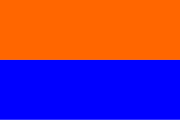
Flag of Nassau-Weilburg
Count Walram II began the Countship of Nassau-Weilburg, which existed to 1816. The sovereigns of this house afterwards governed the Duchy of Nassau until 1866 and from 1890 the Grand Duchy of Luxembourg. The branch of Nassau-Weilburg ultimately became rulers of Luxembourg. The Walram line received the lordship of Merenberg in 1328 and Saarbrücken (by marriage) in 1353.
Counts of Nassau-Weilburg (1344–1688)[]
- 1344–1371: John I

Map of Nassau-Weilburg as of 1789
- 1371–1429: Philipp I of Nassau-Weilburg, and (from 1381) Count of Saarbrücken
- 1429–1492: Philip II
- 1492–1523: Louis I
- 1523–1559: Philip III
- 1559–1593: Albert
- 1559–1602: Philip IV
- 1593–1625: Louis II, Count of Nassau-Weilburg and in Ottweiler, Saarbrücken, Wiesbaden, and Idstein
- 1625–1629: William Louis, John IV and Ernest Casimir
- 1629–1655: Ernest Casimir
- 1655–1675: Frederick
- 1675–1688: John Ernst
Princely counts of Nassau-Weilburg (1688–1816)[]
- 1688–1719: John Ernst
- 1719–1753: Charles August
- 1753–1788: Charles Christian
- 1788–1816: Frederick William
- 1816: Wilhelm, Prince of Nassau-Weilburg and Duke of Nassau — Nassau-Weilburg merged into Duchy of Nassau
Dukes of Nassau (1816–1866)[]
- 1816–1839: Wilhelm
- 1839–1866: Adolf
In 1866, Prussia annexed the Duchy of Nassau as the duke had been an ally of Austria in the Second Austro-Prussian War. In 1890, Duke Adolf would become Grand Duke Adolphe of Luxembourg.
Grand Dukes of Luxembourg (from the House of Nassau-Weilburg) - 1890–1912 and succession through a female onwards[]
- 1890–1905: Adolphe
- 1905–1912: William IV
- 1912–1919: Marie-Adélaïde
- 1919–1964: Charlotte
- 1964–2000: Jean
- 2000–present: Henri
From a morganatic marriage, contracted in 1868, descends a family, see Count of Merenberg, which in 1907 was declared non-dynastic. Had they not been excluded from the succession, they would have inherited the headship of the house in 1912.
Counts of Nassau-Wiesbaden-Idstein (1344–1728)[]
- 1344–1370: Adolph I
- 1370–after 1386: Gerlach II, Count of Nassau-Wiesbaden
- 1370–1393: Walram IV, Count of Nassau-Idstein; inherited Wiesbaden when Gerlach II died
- 1393–1426: Adolph II
- 1426–1480: John II
- 1480–1509: Philip, Count of Nassau-Idstein
- 1480–1511: Adolf III, Count of Nassau-Wiesbaden; inherited Idstein in 1509
- 1511–1558: Philip I
- 1558–1566: Philip II
- 1566–1568: Balthasar
- 1568–1596: John Louis I
- 1596–1599: John Philip, jointly with his brother John Louis II
- 1596–1605: John Louis II
- 1605–1627: Louis II
- 1627–1629: William Louis
- 1629–1677: John, Count of Nassau-Idstein, and (from 1651) in Wiesbaden, Sonnenberg, Wehen, Burg-Schwalbach and Lahr
- 1677–1721: George August Samuel (1688–1721)
- 1721–1723: Charles Louis
- 1723–1728: Frederick Louis, Count of Nassau-Ottweiler (1680–1728), and in Rixingen (1703–28), and Idstein (1721–1728), and in Wiesbaden, etc. (1723–28)
After Frederick Louis's death, Nassau-Wiesbaden-Idstein fell to Charles, Prince of Nassau-Usingen
Counts of Nassau-Saarbrücken (1429–1797)[]
- 1429–1472: John II
- 1472–1545: John Louis I
- 1545–1554: Philip II
- 1554–1574: John III
- 1574–1602: Philip IV, as Philip III of Nassau-Saarbrücken
- 1602–1625: Louis II, Count of Nassau-Saarbrücken and Ottweiler
- 1629–1640: William Louis, Count of Nassau-Saarbrücken and Ottweiler
- 1640–1642: Crato
- 1642–1659: John Louis II, Count of Nassau-Saarbrücken and (1659–80) in Ottweiler, Jungenheim, and Wöllstein
- 1659–1677: Gustav Adolph
- 1677–1713: Louis Crato
- 1713–1723: Charles Louis
- 1723–1728: Frederick Louis
- 1728–1735: Charles
- 1735–1768: William Henry, first Prince of Nassau-Saarbrücken
- 1768–1794: Louis
- 1794–1797: Henry Louis
After Henry Louis's death, Nassau-Saarbrücken fell to Charles William, Prince of Nassau-Usingen
Princes of Nassau-Usingen (1659–1816)[]
- 1659–1702: Walrad, elevated to Prince
- 1702–1718: William Henry
- 1718–1775: Charles
- 1775–1803: Charles William
- 1803–1816: Frederick Augustus
In 1816, Nassau-Usingen merged with Nassau-Weilburg to form the Duchy of Nassau. See "Dukes of Nassau" above.
The Ottonian Line[]

Arms and crest of the Ottonian line (since the 13th century)
- 1255–1290: Otto I, Count of Nassau in Siegen, Dillenburg, Beilstein, and Ginsberg
- 1290–1303: Joint rule by Henry, John and Emicho I, sons of Otto I
In 1303, Otto's sons divided the possessions of the Ottonian line. Henry received Nassau-Siegen, John received Nassau-Dillenburg and Emicho I received Nassau-Hadamar. After John's death. Nassau-Dillenburg fell to Henry.
Counts of Nassau-Dillenburg[]
- 1303–1328: John in Dillenburg, Beilstein and Herborn, and (from 1320) in Katzenelnbogen
- 1328–1343: Henry, from 1303 in Siegen, Ginsberg, Haiger, and the Westerwald, and from 1328 in Dillenburg, Herborn, and Beilstein
- 1343–1350: Otto II
- 1350–1416: John I
- Tetrarchy
- 1416–1420: Adolf
- 1420–1429: John III
- 1420–1442: Engelbert I
- 1420–1443: John II
- 1442–1451: Henry II
- 1448–1475: John IV
- 1475–1504: Engelbert II
- 1504–1516: John V
- 1516–1538: Henry III
- 1538–1559: William I
- 1559–1606: John VI
- 1606–1620: William Louis
- 1620–1623: George
- 1623–1662: Louis Henry, Prince of Nassau-Dillenburg from 1654
- 1662–1701: Henry
- 1701–1724: William II
- 1724–1739: Christian
In 1739, Nassau-Dillenburg fell to Nassau-Dietz, a.k.a. Orange-Nassau.
Counts of Nassau-Beilstein[]
In 1343, Nassau-Beilstein was split off from Nassau-Dillenburg.
- 1343–1388: Henry I
- 1388–1410: Henry II, jointly with his brother Reinhard
- 1388–1412: Reinhard
- 1412–1473: John I, jointly with his brother Henry III
- 1412–1477: Henry III
- 1473–1499: Henry IV
- 1499–1513: John II
- 1513–1561: John III, jointly with his brother Henry V
- 1513–1525: Henry V
After John III's death, Nassau-Beilstein fell back to Nassau-Dillenburg. It was split off again in 1607 for George, who inherited the rest of Nassau-Dillenburg in 1620.
Counts and Princes of Nassau-Hadamar[]
- 1303–1334: Emicho I, Count in Driedorf, Esterau, and Hadamar, married Anna of Nuremberg
- 1334–1364: John, married Elisabeth of Waldeck
- 1334–1359: Emicho II, son of Emicho I, married Anna of Dietz
- 1364–1369: Henry, son of John, Count of Nassau-Hadamar
- 1369–1394: Emicho III, son of John
After Emicho III's death, Nassau-Hadamar fell back to Nassau-Dillenburg.
In 1620, the younger line of Nassau-Hadamar was split off from Nassau-Dillenburg
- 1620–1653: John Louis, son of John VI of Nassau-Dillenburg, Prince from 1650
- 1653–1679: Maurice Henry, son of John Louis
- 1679–1711: Francis Alexander, son of Maurice Henry
In 1711, Nassau-Hadamar was divided between Nassau-Dietz, Nassau-Dillenburg, and Nassau-Siegen.
Nassau-Siegen[]
The branch of Nassau-Siegen was a collateral line of the House of Nassau, and ruled in Siegen. The first Count of Nassau in Siegen was Count Henry, Count of Nassau in Siegen (d. 1343), the elder son of Count Otto I of Nassau. His son Count Otto II of Nassau ruled also in Dillenburg.
- 1303–1343: Henry, Count of Nassau in Siegen, Ginsberg, Haiger, and the Westerwald, and (1328–1343) in Dillenburg, Herborn, and Beilstein
In 1328, John of Nassau-Dillenburg died unmarried and childless, and Dillenburg fell to Henry of Nassau-Siegen. For counts of Nassau-Siegen in between 1343 and 1606, see "Counts of Nassau-Dillenburg" above.
In 1606 the younger line of Nassau-Siegen was split off from the House of Nassau-Dillenburg. After the main line of the House became extinct in 1734, Emperor Charles VI transferred the county to the House of Orange-Nassau.
Counts and Princes of Nassau-Siegen[]

Gozdzki - de Nassau Palace in Warsaw that belonged to wealthy Karolina Gozdzka (1747–1807) and her husband Charles Henry de Nassau-Siegen (1745–1808).[4]
- 1606–1623 John I
- 1623–1638 John II
- 1638–1674 George Frederick
- 1674–1679 John Maurice
- 1679–1691 William Maurice
- 1691–1699 John Francis Desideratus
- 1699–1707 William Hyacinth
- 1707–1722 Frederick William Adolf
- 1722–1734 Frederick William II
In 1734, Nassau-Siegen fell to Nassau-Dietz, a.k.a. Orange-Nassau.
Counts and Princes of Nassau-Dietz[]

Princes of the House of Nassau-Dietz from the Stadhouderlijk Hof of Paleis in Leeuwaarden, H.Prince of Nassau, Henry Casimir, Prince of Nassau, George, Prince of Nassau, and Willem Frederick, Prince of Nassau_Dietz
- 1606–1632: Ernst Casimir
- 1632–1640: Henry Casimir I
- 1640–1664: William Frederick, Prince from 1650
- 1664–1696: Henry Casimir II of Nassau-Dietz, Prince of Nassau-Dietz
- 1696–1711: John William Friso, Prince of Nassau-Dietz (after 1702 also Prince of Orange)
Orange-Nassau[]
The House of Orange-Nassau stems from the Ottonian Line. The connection was via Engelbert I, who offered his services to the Duke of Burgundy, married a Dutch noblewoman and inherited lands in the Netherlands, with the barony of Breda as the core of his Dutch possessions.

William I. "the Silent" (1545–1584), founder of the Netherlands, statue at Wiesbaden
The importance of the Nassaus grew throughout the 15th and 16th century. Henry III of Nassau-Breda was appointed stadtholder of Holland, Zeeland and Utrecht by Emperor Charles V in the beginning of the 16th century. Henry was succeeded by his son, René of Châlon-Orange in 1538, who was, as can be inferred from his name, a Prince of Orange. When René died prematurely on the battlefield in 1544 his possessions and the princely title passed to his cousin, William the Silent, a Count of Nassau-Dillenburg. By dropping the suffix name "Dillenburg" (of the Orange-Nassau-Dillenburg), from then on the family members called themselves "Orange-Nassau."
With the death of William III, the legitimate direct male line of William the Silent became extinct and thereby the first House of Orange-Nassau. John William Friso, the senior agnatic descendant of William the Silent's brother and a cognatic descendant of Frederick Henry, grandfather of William III, inherited the princely title and all the possessions in the low countries and Germany, but not the Principality of Orange itself. The Principality was ceded to France under the Treaty of Utrecht that ended the wars with King Louis XIV. John William Friso, who also was the Prince of Nassau-Dietz, founded thereby the second House of Orange-Nassau (the suffix name "Dietz" was dropped of the combined name Orange-Nassau-Dietz).
After the post-Napoleonic reorganization of Europe, the head of House of Orange-Nassau gained the title "King/Queen of the Netherlands".
Princes of Orange[]
House of Orange-Nassau(-Dillenburg), first creation[]
- 1544–1584: William I, also Count of Katzenelnbogen, Vianden, Dietz, Buren and Leerdam and Lord of IJsselstein
- 1584–1618: Philip William, also Count of Nassau-Dillenburg, Count of Vianden, Buren and Leerdam and Lord of IJsselstein
- 1618–1625: Maurice, also Count of Nassau-Dillenburg, Count of Vianden, Buren and Leerdam and Lord of IJsselstein
- 1625–1647: Frederick Henry, also Count of Nassau-Dillenburg, Count of Vianden, Buren and Leerdam and Lord of IJsselstein
- 1647–1650: William II, also Count of Nassau-Dillenburg, Count of Vianden, Buren and Leerdam and Lord of IJsselstein
- 1650–1702: William III, also Count of Nassau-Dillenburg, Count of Vianden, Buren and Leerdam, Lord of IJsselstein and (from 1689) King of England, Scotland, and Ireland
In 1702, the Orange-Nassau-Dillenburg line died out and its possessions fell to the Nassau-Dietz line.
House of Orange-Nassau(-Dietz), second creation[]
- 1702–1711: John William Friso, also Prince of Nassau-Dietz, Count of Vianden, Buren and Leerdam and Lord of IJsselstein
- 1711–1751: William IV, also Prince of Nassau-Dietz, Count of Vianden, Buren and Leerdam and Lord of IJsselstein
- 1751–1806: William V, also Prince of Nassau-Dietz, Count of Vianden, Buren and Leerdam and Lord of IJsselstein
- 1806–1815: William VI, also Prince of Fulda and Count of Corvey, Weingarten and Dortmund; in 1815 became King William I of the Netherlands

Royal Coat of Arms of the Netherlands
Kings and Queens of the Netherlands (from the House of Orange-Nassau-Dietz)[]
- 1815–1840: William I, also Duke and Grand Duke of Luxemburg and Duke of Limburg
- 1840–1849: William II, also Grand Duke of Luxemburg and Duke of Limburg
- 1849–1890: William III, also Grand Duke of Luxemburg and Duke of Limburg
- 1890–1948: Wilhelmina
Following German laws, the House of Orange-Nassau(-Dietz) has been extinct since the death of Wilhelmina (1962). Dutch laws and the Dutch nation do not consider it extinct.
- 1948–1980: Juliana
- 1980–2013: Beatrix
- 2013-present: Willem-Alexander
Family Tree[]
The following family tree is compiled from Wikipedia and the reference cited in the note[5]
| Dudo-Henry of Laurenburg (German: Dudo-Heinrich) (ca. 1060 – ca. 1123) was Count of Laurenburg in 1093 | |||||||||||||||||||||||||||||||||||||||||||||||
| Robert I of Nassau (German: Ruprecht) (ca. 1090 – ca. 1154) was from 1123 co-Count of Laurenburg later title himself 1st Count of Nassau | Arnold I of Laurenburg (died ca. 1148) | ||||||||||||||||||||||||||||||||||||||||||||||
| Robert II (German: Ruprecht) Count of Laurenburg (1154-1158)(died ca. 1159) | Walram I of Nassau (French: Valéran) (ca. 1146–1198) was the first (legally titled) Count of Nassau (1154-1198) | Henry (Heinrich) I co-Count of Nassau (1160 - August 1167) | Robert III, the Bellicose German: Ruprecht der Streitbare (died 1191) co-Count of Nassau (1160-1191) | ||||||||||||||||||||||||||||||||||||||||||||
| Henry (Heinrich) II, the Rich Count of Nassau (1180–1251) | Robert (Ruprecht) IV Count of Nassau (1198–1230) Teutonic Knight (1230–1240) | Herrmann (d after 3 December 1240) Canon of Mainz Cathedral | |||||||||||||||||||||||||||||||||||||||||||||
| Walram II of Nassau (ca. 1220 - 1276) the WALRAMIAN Branch present-day rulers of Luxembourg descend from him | Robert (Ruprecht) V d. before 1247 Teutonic Knight (1230–1240) | Otto I of Nassau (reigned ca. 1247 - 1290) the OTTONIAN branch the present-day rulers of the Netherlands descend from him | John (ca. 1230 - 1309) Bishop-Elect of Utrecht (1267–1290) | ||||||||||||||||||||||||||||||||||||||||||||
| Adolf (ca. 1255-1298) King of Germany (1292 - 1298) | Henry (d. 1343) Count of Nassau in Siegen | Emich (d. 7 June 1334) Count of Nassau in Hadamar extinct 1394 | John (d. 1328) Count Nassau in Dillenburg | ||||||||||||||||||||||||||||||||||||||||||||
| Ruprecht (+ 1304) | Gerlach I, Count of Nassau-Wiesbaden (bef 1288 +1361) | Walram III Count of Nassau-Wiesbaden | Otto II (c. 1305 – 1330/1331) Count of Nassau-Dillenburg | Henry (1307-1388) Count of Nassau-Beilstein ext. 1561 | |||||||||||||||||||||||||||||||||||||||||||
| Adolph (1307 +1370) Count of Nassau in Wiesbaden-Idstein ext 1605 | John I (1309 +1371) Count of Nassau-Weilburg | Rupert 'the Bellicose' (c. 1340 +1390) Count of Nassau-Sonnenberg | John I (1340 +1416) Count of Nassau-Dillenburg | ||||||||||||||||||||||||||||||||||||||||||||
| Philip I 1368 +1429) Count of Nassau in Weilburg,Saarbrücken, etc. | Adolph (1362 +1420) Count of Nassau-Dillenburg-Dietz | John II "The Elder" ( +1443) | Engelbert I (c. 1370/80 +1442) Count of Nassau, Baron of Breda founder of the Netherlands Nassaus | John III "The Younger" (+1430) Count of Nassau in Siegen | |||||||||||||||||||||||||||||||||||||||||||
| Philip II (1418 +1492) Count of Nassau-Weilburg | John II (1423 +1472) Count of Nassau-Saarbrücken ext. 1574 | John IV (Jan) (1410, +1475) Count of Nassau-Dillenburg-Dietz | Henry II (1414 +1450) Count of Nassau-Dillenburg | ||||||||||||||||||||||||||||||||||||||||||||
| John III (1441 +1480) Count of Nassau-Weilburg | Philip (1443-1471) Count of Nassau-Weilburg | Engelbert II the Valorious (1451 +1504) Count of Nassau and Vianden, Baron of Breda(fr), Lek, Diest, Roosendaal en Nispen and Wouw | John V (1455 +1516) Count of Nassau in Dillenburg,Siegen,Hadamar,Herborn,Vianden,Dietz | ||||||||||||||||||||||||||||||||||||||||||||
| From here descends the House of Nassau-Weilburg and the Grand Ducal Family of Luxembourg (see below also)' | From here descends the House of Orange-Nassau (see below also) | ||||||||||||||||||||||||||||||||||||||||||||||
House of Orange and Nassau[]
A summary family tree of the House of Orange-Nassau [6] from the joining of the house of Nassau-Breda/Dillenburg and the House of Châlon-Arlay-Orange to the end of the Dutch Republic is shown below. The family spawned many famous statesmen and generals, including two of the acknowledged "first captains of their age", Maurice of Nassau and the Marshal de Turenne.
| John V Count of Nassau-Dietz, 1455-1516, Stadholder of Gelderland | John IV Prince of Orange, 1475-1502 | ||||||||||||||||||||||||||||||||||||||||||||||||||||||||||||||||||||||||||||||||
| William the Rich Count of Nassau-Dillenburg 1487- 1559 | Henry III Count of Nassau-Breda 1483-1538 | Claudia of Châlon 1498–1521 | Philibert of Châlon, Prince of Orange, 1502-1530 | ||||||||||||||||||||||||||||||||||||||||||||||||||||||||||||||||||||||||||||||
| William I "the Silent" 1533-1584, Prince of Orange 1544, Stadholder of Holland, Zealand & Utrecht, assassinated by Spanish agent | Louis 1538–1574 died in battle against Spain | Adolf 1540–1568, died in battle against Spain | Henry 1550-1574 died in battle against Spain | John VI "the Elder" 1535–1606, Stadholder of Gelderland | René of Châlon 1519–1544, Prince of Orange,1521 | ||||||||||||||||||||||||||||||||||||||||||||||||||||||||||||||||||||||||||||
| Philip William 1554–1618, Prince of Orange, 1584 | Maurice 1567–1625, Prince of Orange,1618, Stadholder of Holland, Zealand, Utrecht, etc. | Frederick Henry 1584–1647, Prince of Orange, 1625, Stadtholder of Holland, Zeeland, & etc. | Louise Juliana 1576-1644 married Frederick IV Elector Palatinefrom whom the British royal family descends | Elisabeth 1577-1642 married Henri de La Tour d'Auvergne, Duke of Bouillon | illeg. Justinus van Nassau (1559 – 1631) Admiral & General, Gov of Breda 1601-1625 | William Louis "Us Heit", Count of Nassau-Dillenburg 1560–1620, Stadtholder of Friesland, Groningen, and Drenthe | Ernst Casimir, Count of Nassau-Dietz 1573–1632, Stadtholder of Friesland, Groningen, and Drenthe | John VII "the Middle", Count of Nassau-Siegen, 1561–1623 | |||||||||||||||||||||||||||||||||||||||||||||||||||||||||||||||||||||||||
| illeg William of Nassau (1601–1627), lord of de Lek | illeg Louis of Nassau, Lord of De Lek and Beverweerd (1602– 1665) | Frederick V, Elector Palatine, 1610 & King of Bohemia 1619-21 | Henri de la Tour d'Auvergne, Vicomte de Turenne & Marshal-General of France 1611-1675 | ||||||||||||||||||||||||||||||||||||||||||||||||||||||||||||||||||||||||||||||
| Charles I, King of England 1625-1649 | |||||||||||||||||||||||||||||||||||||||||||||||||||||||||||||||||||||||||||||||||
| Charles II | |||||||||||||||||||||||||||||||||||||||||||||||||||||||||||||||||||||||||||||||||
| William II 1626-1650,Prince of Orange & Stadholder of Holland, Zealand, etc, 1647 | Mary,Princess Royal | James II | Louise Henriette (1627-1667) married Frederick William, Elector of Brandenburg descendants were Kings of Prussia and later German Emperors | illeg. Frederick Nassau de Zuylestein (1608–1672) general of the army, descendants were the Earls of Rochford in England | Albertine Agnes(1634– 1696) | William Frederick,1613-1664 Count later Prince of Nassau-Dietz,Stadtholder of Friesland, Groningen and Drenthe | Henry Casimir I Count of Nassau-Dietz,1612–1640,Stadtholder of Friesland, Groningen and Drenthe | John Maurice "the Brazilian", Prince of Nassau-Siegen,1604–1679,gov. of Dutch Brazil, Field Marshal of the Dutch Army | |||||||||||||||||||||||||||||||||||||||||||||||||||||||||||||||||||||||||
| William III 1650-1702,Prince of Orange 1650, Stadholder of Holland, Zealand, etc, 1672, King of England, 1689 | Mary II of England | ceded claims to the lands of Orange to France in 1713, but kept right to use the title in its German form: currently Georg Friedrich, Prince of Prussia, "Prinz von Oranien" | Henry Casimir II, Prince of Nassau-Dietz,1657-1696,Stadtholder of Friesland, Groningen and Drenthe | ||||||||||||||||||||||||||||||||||||||||||||||||||||||||||||||||||||||||||||||
| John William Friso 1687-1711, appointed heir by William III, Prince of Orange, 1702, Stadholder of Friesland 1696 | |||||||||||||||||||||||||||||||||||||||||||||||||||||||||||||||||||||||||||||||||
| Anne, Princess Royal of England | William IV 1711–1751, Prince of Orange, Stadholder of Holland, Zealand, etc. 1747 | ||||||||||||||||||||||||||||||||||||||||||||||||||||||||||||||||||||||||||||||||
| Wilhelmina of Prussia | William V 1748–1806, Prince of Orange,1751 Stadholder of Holland, Zealand, etc. 1751-1795 | Carolina 1743–1787 | Charles Christian, Prince of Nassau-Weilburg, 1735-1788 | ||||||||||||||||||||||||||||||||||||||||||||||||||||||||||||||||||||||||||||||
| Princess Louise of Orange-Nassau, 1770– 1819 married Karl, Hereditary Prince of Braunschweig(-Wolfenbuttel), son of Princess Augusta of Great Britain | Prince Frederick of Orange-Nassau, 1774–1799 an Austrian General, no issue | William VI, Fürst of Nassau-Orange-Fulda 1803–1806, Fürst of Nassau-Orange, Prince of Orange 1806 later William I, King of the Netherlands 1815 | Frederick William, Prince of Nassau-Weilburg, 1768-1816 | ||||||||||||||||||||||||||||||||||||||||||||||||||||||||||||||||||||||||||||||
| Royal Family of the Netherlands, see next table below | William, Duke of Nassau, 1792-1839 | ||||||||||||||||||||||||||||||||||||||||||||||||||||||||||||||||||||||||||||||||
| Adolphe 1817–1905, Duke of Nassau 1839-1866,Grand Duke of Luxembourg, 1890-1905 | |||||||||||||||||||||||||||||||||||||||||||||||||||||||||||||||||||||||||||||||||
| Grand Ducal Family of Luxembourg | |||||||||||||||||||||||||||||||||||||||||||||||||||||||||||||||||||||||||||||||||
| William I, 1772-1843, King of the Netherlands, 1815-1840 | Wilhelmina of Prussia | ||||||||||||||||||||||||||||||||||||||||||||||||||||||||||||||
| William II, 1792-1849, King of the Netherlands, 1840 | Anna Pavlovna of Russia | Prince Frederick of the Netherlands, 1797-1881 [7][8] | Princess Pauline of Orange-Nassau, 1800-1806 | Princess Marianne of the Netherlands, 1810-1883 [9] married Prince Albert of Prussia (1809–1872) | |||||||||||||||||||||||||||||||||||||||||||||||||||||||||||
| Emma of Waldeck-Pyrmont | William III, 1817-1890, King of the Netherlands, 1849 | Sophia of Württemberg | Prince Alexander of the Netherlands, 1818–1848 | Prince Henry of the Netherlands, "the Navigator" 1820–1879 | Princess Sophie of the Netherlands, 1824–1897 married Charles Alexander, Grand Duke of Saxe-Weimar-Eisenach | Princess Louise of the Netherlands,1828–1871 married Charles XV of Sweden | Princess Marie of the Netherlands, 1841-1910 married William, Prince of Wied one son was William, Prince of Albania | ||||||||||||||||||||||||||||||||||||||||||||||||||||||||
| Wilhelmina, 1880-1962, Queen of the Netherlands, 1890-1948 To 1907 after 1907 | Henry of Mecklenburg-Schwerin 1876-1934, Prince of the Netherlands | William, Prince of Orange 1840-1879 | Prince Maurice of the Netherlands1843-1850 | Alexander, Prince of Orange, 1851-1884 | |||||||||||||||||||||||||||||||||||||||||||||||||||||||||||
| Juliana 1909-2004, Queen of the Netherlands, 1948-1980 | Prince Bernhard of Lippe-Biesterfeld, Prince of the Netherlands 1911-2004 | ||||||||||||||||||||||||||||||||||||||||||||||||||||||||||||||
| Beatrix,1938-, Queen of the Netherlands,1980-2013 | Claus van Amsberg,1926-2002, Prince of the Netherlands | Princess Irene of the Netherlands, 1939, m.(1964–1981) Carlos Hugo of Bourbon-Parma, Duke of Parma, 4 children not eligible for throne | Princess Margriet of the Netherlands, 1943- | Pieter van Vollenhoven | Princess Christina of the Netherlands,1947, m. Jorge Pérez y Guillermo (m. 1975; div. 1996), 3 children not eligible for throne | ||||||||||||||||||||||||||||||||||||||||||||||||||||||||||
| William-Alexander of the Netherlands,1967- Prince of Orange & Heir Apparent, 1980, King of the Netherlands, 2013- | Queen Maxima of the Netherlands | Prince Friso of Orange-Nassau 1968-2013 m.(2004) Mabel Wisse Smit without permission, his children are not eligible for the throne and he was no longer a Prince of the Netherlands after his marriage | Prince Constantijn of the Netherlands, 1969- | Princess Laurentien of the Netherlands | 4 sons, 2 of whom were eligible for the throne until Beatrix abdicated in 2013 | ||||||||||||||||||||||||||||||||||||||||||||||||||||||||||
| Princess Catharina-Amalia of the Netherlands,2003- Princess of Orange & heiress apparent, 2013- | Princess Alexia of the Netherlands, 2005- | Princess Ariane of the Netherlands, 2007- | Countess Eloise of Orange-Nassau, 2002- | Count Claus-Casimir of Orange-Nassau, 2004- | Countess Leonore of Orange-Nassau, 2006- | ||||||||||||||||||||||||||||||||||||||||||||||||||||||||||
House of Nassau-Weilburg[]
Complied from Wikipedia and:[10]
| For ancestors of the House of Nassau-Weilburg (House of Nassau family tree)' | |||||||||||||||||||||||||||||||||||||||||||
| John III (1441 +1480) Count of Nassau-Weilburg | |||||||||||||||||||||||||||||||||||||||||||
| Louis I (1473 +1523) Count of Nassau-Weilburg | |||||||||||||||||||||||||||||||||||||||||||
| Philip III (1504 +1559) Count of Nassau-Weilburg | |||||||||||||||||||||||||||||||||||||||||||
| Albert (1537 +1593) Count of Nassau-Weilburg | Philip IV (1542 +1602) Count of Nassau-Weilburg in Saarbrucken | ||||||||||||||||||||||||||||||||||||||||||
| Louis II (1565 +1627) Count of Nassau-Weilburg in Ottweiler | William (1570–1597) Count of Nassau-Weilburg in Weilburg | John Casimir (1577 +1602) Count of Nassau-Weilburg in Gleiberg | |||||||||||||||||||||||||||||||||||||||||
| William Louis (1590 +1640) Count of Nassau-Saarbrücken | John (1603 +1677) Count of Nassau-Idstein Counts of Nassau-Idstein ext.1721 | Ernest Casimir (1607 +1655) Count of Nassau-Weilburg | |||||||||||||||||||||||||||||||||||||||||
| John Louis (1625 +1690) Count of Nassau-Ottweiler ext. 1728 | Gustav Adolph (1632 +1677) Count of Nassau-Saarbrücken ext. 1723 | Walrad (1635 +1702) Count & Prince of Nassau-Usingen ext. 1816 | Frederick (1640 +1675) Count of Nassau-Weilburg | ||||||||||||||||||||||||||||||||||||||||
| John Ernst (1664 +1719) Count & Prince of Nassau-Weilburg | |||||||||||||||||||||||||||||||||||||||||||
| Charles August (1685 +1753) Prince of Nassau-Weilburg | Charles Ernst (1689–1709) Prince of Nassau-Weilburg | ||||||||||||||||||||||||||||||||||||||||||
| Charles Christian (1735 +1788) Prince of Nassau-Weilburg | Princess Carolina of Orange-Nassau (1743 +1787) | ||||||||||||||||||||||||||||||||||||||||||
| Frederick William (1768 +1816) Prince of Nassau-Weilburg | |||||||||||||||||||||||||||||||||||||||||||
| William (1792 +1839) Duke of Nassau | |||||||||||||||||||||||||||||||||||||||||||
| Adolphe (1817 +1905) Duke of Nassau 1839-1866 Grand Duke of Luxembourg 1890-1905 File:Crown of Luxembourg.pngFile:Crown of Luxembourg.png | |||||||||||||||||||||||||||||||||||||||||||
| Grand Ducal Family of Luxembourg | |||||||||||||||||||||||||||||||||||||||||||
The Grand-Ducal Family of Luxembourg[]
Grand Ducal Family of Luxembourg
See also[]
- Kings of Germany family tree. The Nassaus were the 9th dynasty to rule Germany and were related by marriage to all the others.
- Archives of the House of Nassau
References[]
- ^ Grand Duchess Charlotte abdicated in 1964, but she died in 1985
- ^ Family tree of the early House of Nassau, retrieved on 2009-01-22.
- ^ Table 11, Page 23 and note on page 151, quoted at Genealogy of the Middle Ages, retrieved on 2009-01-23
- ^ "Pałac Gozdzkich - de Nassau" (in pl). www.warszawa1939.pl. http://www.warszawa1939.pl/index.php?r1=kopernika_nassau&r3=0. Retrieved 2009-03-23.
- ^ Louda, Jiri; Maclagan, Michael (December 12, 1988), "Netherlands and Luxembourg, Table 33", Heraldry of the Royal Families of Europe (1st Ed.(U.S.) edition ed.), Clarkson N. Potter, Inc.;
- ^ "Official Website of the Dutch Royal House". Rijksvoorlichtingsdienst (RVD), The Hague, the Netherlands. http://www.koninklijkhuis.nl/. Retrieved 2013-04-30.
- ^ Rietstap, Johannes Baptist (1875). Handboek der Wapenkunde. the Netherlands: Theod. Bom. p. 348. ""Prins FREDERIK: Het koninklijke wapen, in 't shcildhoofd gebroken door een rooden barensteel, de middelste hanger beladen met een regtopstaanden goud pijl.""
- ^ Junius, J.H. (1894). Heraldiek. the Netherlands: Frederik Muller. p. 151. ""...de tweede oon voert het koninklijk wapen gebroken door een barensteel van drie stukken met een zilveren pijl.""
- ^ Junius, J.H. (1894). Heraldiek. the Netherlands: Frederik Muller. p. 151. ""...is het wapen afgebeeld van de oudste dochter van den Koning der Nederlanden. De barensteel is van keel en beladen met een gouden koningskroon.""
- ^ Louda, Jiri; Maclagan, Michael (December 12, 1988), "Netherlands and Luxembourg, Table 33", Heraldry of the Royal Families of Europe (1st Ed.(U.S.) edition ed.), Clarkson N. Potter, Inc.;
Sources[]
- Genealogy of the Middle Ages - House of Nassau
- Nassau-info.de
- Marek, Miroslav. "Nassau Genealogies". Genealogy.EU. http://genealogy.euweb.cz/nassau/index.html.
- History of titles of the counts, princes and dukes of Nassau based on contemporary documents
| |||||||||||||||||||||||||||||||||||||||||||||||||||||||||||||||||||||||||||||||||||||||||||||||||||||||||||||||||||||
| This page uses content from the English language Wikipedia. The original content was at House of Nassau. The list of authors can be seen in the page history. As with this Familypedia wiki, the content of Wikipedia is available under the Creative Commons License. |
